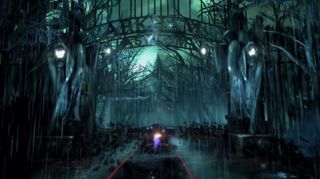Asylum vs City vs Knight: which Batman game is king?
What do you think of when you think of Batman? For me, it’s the cape, the cowl and the Batmobile. It’s the iconic rogue’s gallery, his many allies and Gotham City. Those are the things that most people associate with the Dark Knight. In Rocksteady’s Arkham series, two of which (Asylum and City) have recently been remastered for PS4 and Xbox One, the studio successfully captured these elements of the character’s history and a lot more besides. The bigger the games got, the deeper they went into the Dark Knight’s 77 years of existence, and the more complete a representation of that superhero’s universe they became.
But not everyone believes bigger is better, particularly when it comes to the open world sequels, Arkham City and Knight. There’s definitely a split in opinion over when the Arkham trilogy was at its best – hell, I did my own informal poll on Twitter (the sort of riveting content you get by following me), and around half of those who responded listed 2009’s Asylum as their favourite. The common argument I read in Asylum’s favour (one that I’ve frequently read about in the years since its release) is that it had a focus in its Metroidvania-like, single location structure that its open world successors did not. That’s not to say City doesn’t have plenty of fans, too – but people definitely covet Asylum for how it distills the Batman experience down into something that’s familiarly video game-y, in an environment where Bruce Wayne is more vulnerable to his enemies. For the people who don’t truly love Batman, and don’t absorb too much enjoyment from his extensive lore, I think Asylum just offers a more coherent and satisfying journey.

In no way is my poll an exact representation of the millions who have played these games, though. It just demonstrates the obvious passion some players have for what Asylum did versus what City and Knight offered. Everything that happens in Asylum takes place within the walls of that locale – unless you count Batman’s secret Batcave, which he has hidden in a cove around the corner from the institution – whereas City and Knight take him into more comprehensive depictions of a real, functioning Gotham City. In doing this, Rocksteady got closer to realising the fantasy of being Batman: the playing space got larger, the location became awash with a wider range of his villains, both iconic and obscure, and the premise changed from the inmates taking over the asylum to the inmates taking over an entire populated location. Corridors and courtyards were swapped for an urban sprawl. By Arkham Knight, you had not just a snapshot of Gotham, but the whole thing – not to mention a gorgeous, mighty Batmobile to cruise around it in (even if the vehicle combat left something to be desired).
Here’s the thing – I love all of that stuff from the later games, and I’m supposed to. City and Knight triple down on fan service. Whereas Asylum gives you references to Batman’s wider universe almost out of the corner of your eye, usually through Riddler trophies, City and Knight go ahead and show it. And it isn’t all gold: the Bane sidequest in Arkham City is basically a fetch quest where you travel around the city tracking down barrels. It doesn’t really add anything, and while it has a neat ending that suggests it’s impossible for the villain who once broke Batman’s back to ever truly reform even though he’s trying, you may not give a crap if you haven’t made it your life goal to keep on top of Batman multimedia. It could be argued all the sidequests in Arkham City are open world filler, like you’d find on the icon-sprayed map of an Assassin’s Creed game - they just happen to each be tied to a major Batman villain, brought to life with such high production values for the first time in a game. Of course, a few of them, like the Metal Gear-esque boss fight with Mr Freeze, are genuinely inventive additions to Asylum’s formula.

My theory on this is that the deeper Rocksteady got into the DC Universe, the less that resonated with the people who loved Asylum because it was distilled. If you don’t love the lore of Batman, these villains might as well be anyone. And, where Asylum is more or less one long, coherent quest, the way City and Knight are broken up into chunks across the map - with constant prompts to go investigate them - can be off-putting to people who preferred the first game. Broadly speaking, that’s where I think the difference in opinion comes from. If you love Batman, it’s all out there waiting to be found, a treasure trove of the character’s history that’s a definitive vision of that universe you will never see in a live action movie. If you’re just in it for the game part, though, you’re being pulled in different directions as you might in any other open world.
Asylum is not my favourite in the series for a few reasons, but I don’t think it’s as easy to call a winner among the Arkham games as it is with something like Uncharted (Golden Abyss, obviously) or Resident Evil (clearly, it’s Operation Raccoon City). I don’t think anyone can contest the fact that the combat developed to a pretty great place with City, adding a bunch of new tools to Batman’s armoury like the electric stun gun, or the shield-eliminating freeze blast, which helped extend the life of the game through challenge rooms and leaderboards. Asylum simply doesn’t have that complexity, and a lot of the same types of fights - titans that charge at you, for example - repeat themselves.

At the same time, Arkham Asylum’s Scarecrow hallucinations are without a doubt the peak of the stories told within the series, and are near-impossible to top in how delicately they present Batman’s origins and Bruce Wayne’s continual obsession with his parents’ murder. You don’t need a wide knowledge of Batman’s universe for that to hit hard: everyone knows the tragedy that created this character, and the two sequels don’t really try to one-up it, which is wise. While City and Knight get more fan service-y, they too have their own inventive (and interactive) narrative moments: mourning the chalk outline of the Waynes in Crime Alley, for example, or the Mad Hatter’s BioShock-like creepy dream sequence, or Knight’s stylish first-person opening that sees you playing as a cop wandering around a diner until all hell breaks loose.
Sign up to the GamesRadar+ Newsletter
Weekly digests, tales from the communities you love, and more
On a nerdy level, one of my highlights from Arkham Knight is Bruce telling Nightwing, aka Dick Grayson, the first Robin, that it’s the last time they’ll meet, since he knows his death is on the cards in the game’s finale. Thing is, that means a little more because I’m aware of their history outside of the games, from about a decade of reading comics - the later Arkham entries aren’t nearly as good at being self-contained as Asylum. If you don’t have some existing history with these characters outside the game, it’s likely to just fly over your head.
And plenty of people have no clue who Nightwing is, or Azrael, or Jason Todd: Asylum doesn’t challenge your knowledge on any of this. It’s Batman vs The Joker, brought to life by the actors who portrayed them definitively in the ‘90s animated series, with a few guest appearances along the way. Still, as a work of fan service, the series is collectively as refined as it gets - to have three Batman games (and one decent prequel) this good after years of bad tie-ins, made by people who show so much love for the source material, is still an extraordinary moment in the history of licensed games. Everyone with even a passing affinity for the Caped Crusader is lucky to have them.
In six years, Rocksteady’s Batman games went from a corridor-set Dark Knight adventure set in one location to a sprawling, fully open-world epic that encompassed every aspect of the character’s history. It’s an escalation in ambition that’s comparable to Rockstar’s open world games, and how they progressed from the PS2 age to GTA 5. But Asylum holds a special place in the heart for many. It found the formula for bringing the basic elements of Batman to life in a game straight away: the process of being a detective, the gadgets and beating up nine dudes at once.
Samuel is now a PR Manager at Frontier Development, but was once a staffer at Future PLC. He was last the Entertainment Editor at TechRadar, but before that he was the UK Editor at PC Gamer. He has also written for GamesRadar in his time. He is also the co-host of the Backpage podcast.
Most Popular


